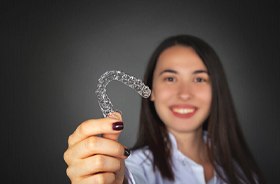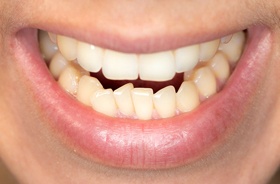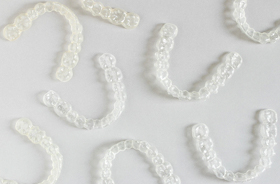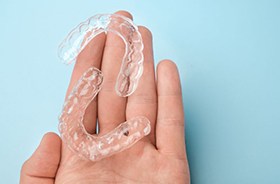Invisalign® – Buzzards Bay, MA
The Discreet Way to Straighten Teeth
Invisalign®, is a remarkably discreet treatment. It has the potential to straighten your teeth, correct bad problems, and close unsightly gaps — all without the use of metal brackets and wires.
Why Choose Canal Side for Invisalign®?
- 1 On-staff orthodontist
- 2 Affordable payment options available
- 3 Appointment slots to accommodate your busy lifestyle
How Invisalign® Works

When teeth are exposed to sustained pressure, they move. Invisalign® applies such pressure though the use of a series of custom-made clear aligner trays. The trays are designed to fit your unique oral structures. You wear each tray for about two weeks, for 20 – 22 hours each day, before you graduate to the next one. After you work your way through all of the aligners, your teeth should be in their ideal positions.
Throughout your treatment period, you must visit our office for periodic Invisalign® checkups. At these brief appointments, we will assess the progress of your treatment and provide you with the next few aligners in your series. After your treatment is complete, we will provide you with a retainer to help you keep your teeth in their new positions.
Indications for Invisalign®

Invisalign® can address a number of orthodontic issues, including:
Crowded Teeth
Spaces Between Teeth
Large gaps between the teeth are unsightly. Invisalign® may be able to close those spaces, thus providing you with more attractive teeth.
Bite Alignment
If your top and bottom teeth do not fit together properly, your misaligned bite can lead to serious issues, including TMJ discomfort and damage to your teeth. In many cases, Invisalign® is able to correct overbite, underbite, and crossbite.
Benefits of Invisalign®

Some of Invisalign’s most outstanding benefits include:
- Although Invisalign® is not entirely invisible, it is quite discreet. It is unlikely to be the first thing onlookers notice about you.
- Because the aligners are removable, Invisalign® allows you to eat and drink practically anything. It also makes brushing and flossing much simpler.
- Many patients believe that the aligners are quite comfortable. Plus, there are not metal brackets and wires that might irritate the soft tissues in your mouth or cause an allergic reaction.
Understanding the Cost of Invisalign

The cost of your Invisalign treatment will depend on how many aligners you need, your age, and other factors. We invite you to visit us for a consultation, wherein we will be able to provide you with a personalized estimate for the price of your treatment. We are an insurance-friendly practice, and we are always happy to help our patients apply for affordable financing if necessary. Remember, Invisalign is an investment that could provide you with increased confidence and a lower risk of dental problems.
Invisalign FAQs
What Does Invisalign Look Like?
Invisalign aligners are clear plastic trays that fit over an entire arch of teeth. When they are on the teeth, they are not totally Invisible. However, they do feature a discreet appearance. They are unlikely to be the first thing that onlookers notice about your appearance.
If you have to use accessories with your aligners, they will not be clear. However, they are not commonly used on the front teeth, so your smile should retain its beautiful appearance.
How Long Does Invisalign Take?
The average treatment time with Invisalign is 12 months. However, your case might require more or less time. It depends largely on the extent of your dental misalignment. Some patients are able to complete treatment in 6 months or so, whereas others need to wear aligners for 18 months or longer. During your consultation, we may be able to provide a rough estimate for how long your treatment will take.
Your age and your compliance with treatment instructions can also have an impact on how long you will need to use Invisalign.
Does Invisalign Hurt?
Invisalign aligners are made of a smooth type of plastic that is designed to rest comfortably against the soft tissues in the mouth. However, it is important to remember that orthodontic treatment is effective because it applies pressure to the teeth. Naturally, that can cause some discomfort, particularly when you are first wearing a new aligner.
You can make your experience as easy as possible by:
- Switching to new aligners at night so you can sleep through the first part of the adjustment period.
- Sipping on cool water.
- Taking appropriate doses of pain medication as necessary.
What Happens After Invisalign?
Once you work your way through all of your Invisalign aligners, we will verify that your results live up to our expectations. Then, we will provide you with a retainer, which will prevent your teeth from drifting back into their former positions. At first, you should wear your retainer 20 – 22 hours each day. Later, though, you might need to wear it only at night. Eventually, it may be necessary just a few nights each week.




